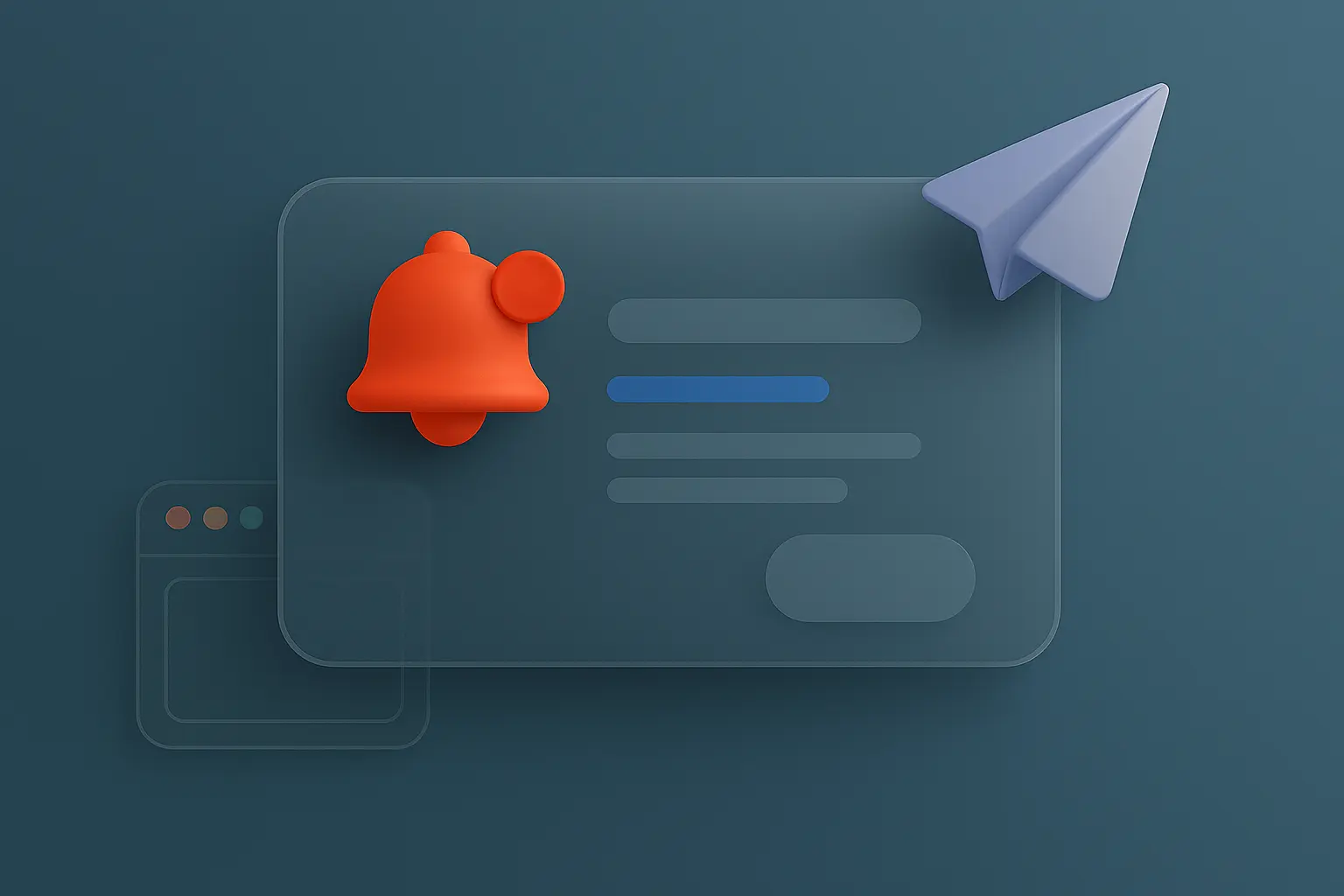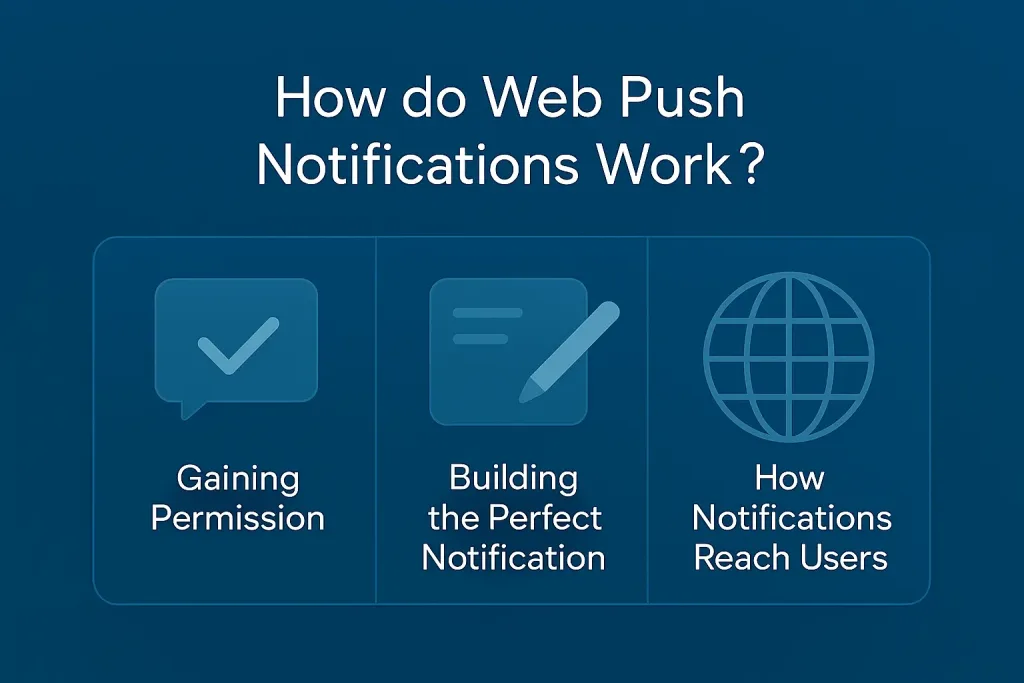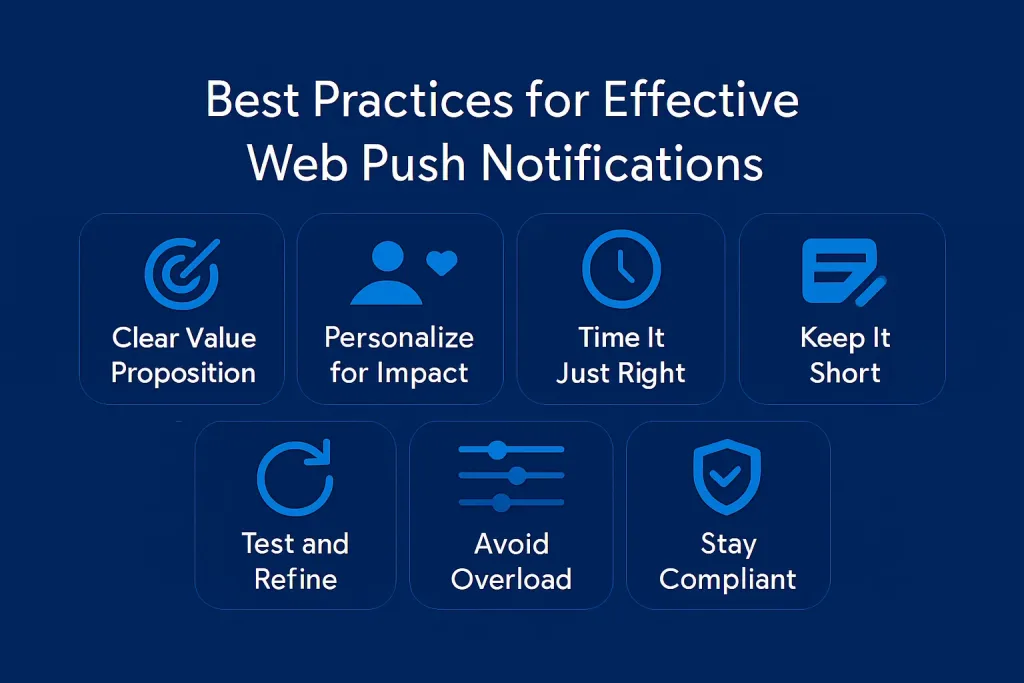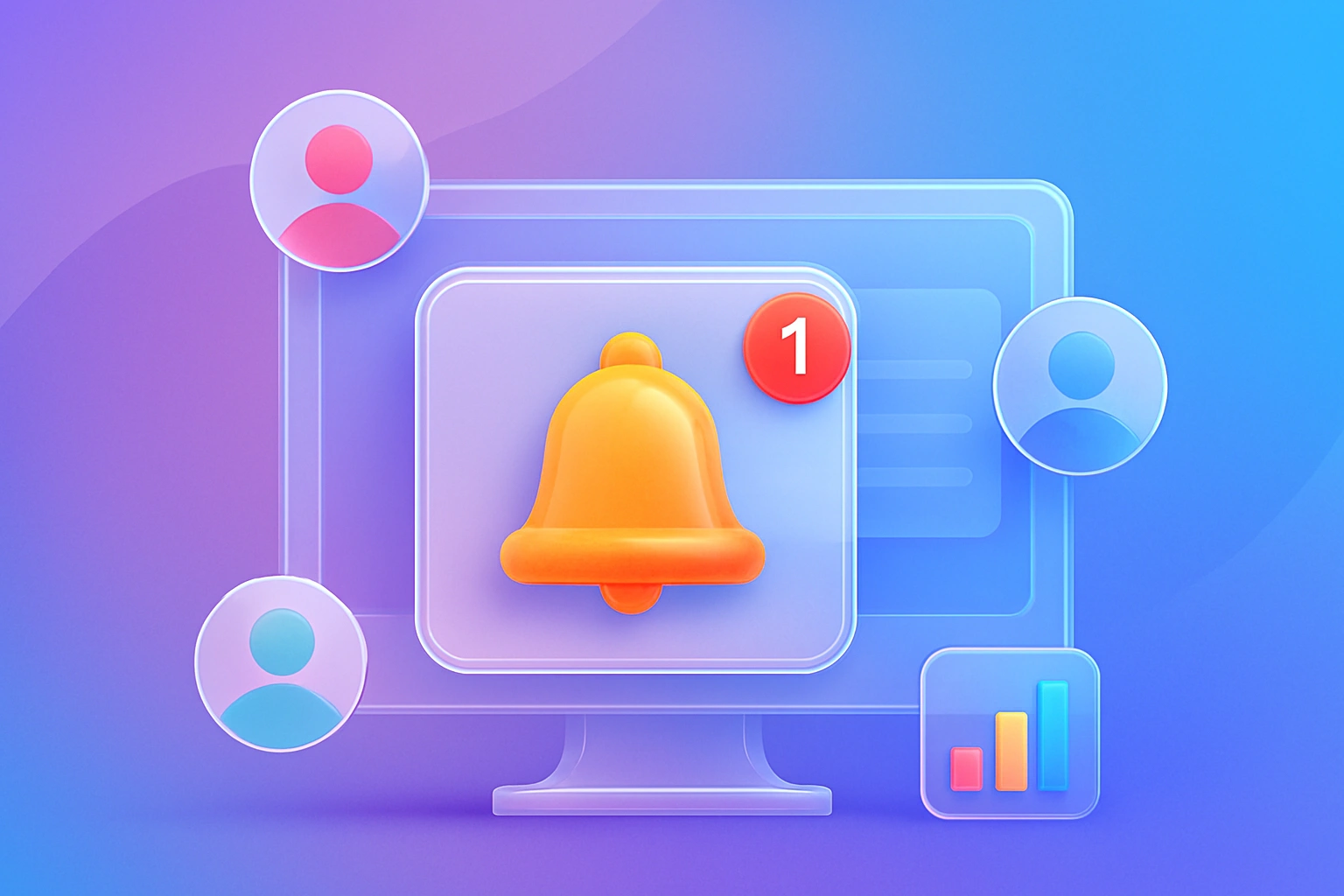What Are Web Push Notifications? A Complete Beginner’s Guide for 2025
- August 25, 2025
- 16 mins read
- Listen

What if you could dominate 2025’s digital frenzy and transform casual browsers into loyal customers with a single, electrifying alert? Web push notifications are your ultimate edge, rising above the clutter with bold flair.
Web push notifications are short, clickable messages sent from your website to desktops or mobiles via browsers, even when users are offline.
They’re permission-based and free on platforms like ours, letting you slap on your logo, craft punchy headlines, and trigger with cool animations (drop-in or slide-in) after a few page views or seconds on-site.
In this guide, we’ll explain how they work, their edge over app pushes, benefits like 88% higher engagement, simple setup, smart practices, and challenge solutions.
Let’s dive in?
What is Web Push Notification?
Web push is a versatile, cost-free way to stay connected, turning casual visitors into engaged fans with a personalized touch.
Ever thought about keeping your audience hooked without them even being on your site? That’s where web push notifications step in. These are snappy, clickable messages sent straight from your website to a user’s desktop or mobile browser.
They pop up even when someone’s not actively scrolling through your pages, as long as their browser is open. It’s like a friendly nudge that keeps your brand in their mind.
What sets this apart?
It’s permission-based, meaning folks opt in via a browser prompt. Plus, with tools like our platform, you get to tweak them with your logo, catchy headlines, and cool animations, drop-in or slide-in, triggered after a few page views or seconds on-site.
For businesses juggling multiple domains, our multi-domain support ensures every message lands perfectly.
How Do Web Push Notifications Work?

Web push notifications combine smart browser technology with server-side finesse to deliver messages effortlessly.
Let’s explore this engaging process step by step, revealing the behind-the-scenes action that keeps your audience connected.
The First Step: Gaining Permission
It all starts when a visitor hits your site. They’re met with a tailored prompt, featuring your logo, a headline like “Unlock Exclusive Updates,” and a simple explanation of the perks.
You decide the timing: right away, after a few page views, or after a set number of seconds. Our platform makes it smooth with drop-in or slide-in animations to grab attention, plus a prompt delay if they say no, offering another chance days later.
Once they opt in, their browser uses the Push API and service workers (background scripts) to create a unique subscription, tying them to your system.
Building the Perfect Notification
Next, your server takes the stage.
You build the notification with a template, up to 70 characters for a snappy header, 250 for the body, and options for icons, banners, or two action buttons like “Check It Out.”
Need control? Set it to auto-hide or expire after minutes, hours, or days. This gets sent to a push service, like Google’s FCM, which holds it if the user’s offline, ready to deliver when they’re back online.
How Notifications Reach Users
The push service then beams the alert to the user’s device, popping it up in their system tray. A click whisks them to your URL.
If they’re offline, it waits patiently. Our platform tracks every move, clicks, dismissals, giving you data to sharpen your approach.
Types of Web Push Notifications
Ready to explore the different flavors of web push notifications that can spice up your connection with users?
These versatile alerts come in various forms, each designed to meet specific needs and keep your audience engaged.
Let’s dive into the options you can leverage.
- Welcome Notifications: Greet new visitors with a warm hello. Send a friendly message right after they opt in, introducing your brand and offering a first-visit perk like a 10% discount code to make them feel at home.
- Cart Abandonment Reminders: Catch those hesitant shoppers. If someone leaves items in their cart, a gentle nudge with a “Don’t forget your goodies!” alert can bring them back, often boosted by our platform’s timed triggers.
- Sales and Discount Alerts: Shout about your deals. Notify users about flash sales or special offers, like “Grab 20% off today only!” These timely pushes can drive quick action and boost conversions.
- Content Updates: Keep your readers in the loop. Share fresh blog posts or videos with a “New article just dropped!” message, encouraging them to dive back into your content.
- Price Drop or Back-in-Stock Alerts: Delight eager buyers. Alert fans when a coveted item’s price dips or restocks with “It’s back, get it now!,” turning waitlists into sales.
Web Push vs. In-App Push Notifications: Key Differences
| Aspect | Web Push Notifications | In-App Push Notifications |
| Setup | Easy, add code or use SDK | Involved, needs app design and testing |
| Device Coverage | Wide—browsers on desktops, tablets, Android | Narrow—only devices with app installed |
| Features | Basic—links, visuals, and custom animations | Advanced—GPS, camera via app tools |
| Cost | Free on our platform, no extra fees | Higher—development and upkeep costs |
| Opt-In | Smooth browser prompts with tools | Via app settings, less flexible |
| Experience | Gentle, respects browser flow | Seamless but app-focused |
| Scalability | Flexible with multi-domain dropdown | Limited by app updates and approvals |
Unsure which notification method aligns with your plans? Web push and in-app push notifications both serve to connect with your audience. They diverge in practical ways that can influence your approach.
Let’s examine these differences to clarify their roles in your strategy.
1. Setup and Accessibility
Web push notifications offer a straightforward start. A bit of website code, or our platform’s free SDK, gets you going without app creation, covering desktops, tablets, and Android mobiles via browsers like Chrome or Firefox.
In contrast, in-app push requires building a native mobile app, involving design, coding, and testing, which can span weeks and incur additional costs.
2. Reach and Device Support
Web push extends to any device with a supported browser to provide wide coverage.
In-app push, however, reaches only devices with your app installed, such as smartphones and tablets, making it better for engaged app users, while web push suits broader outreach.
3. Functionality and Features
In-app push leverages device capabilities like GPS or the camera. It enables detailed interactions such as location-based offers.
Web push focuses on links and visuals, enhanced by our platform’s custom icons and animations, though it lacks deep device integration.
This makes web push ideal for quick updates, while in-app push handles richer experiences.
4. Cost and Maintenance
Web push remains free on our platform with no per-message charges, offering a budget-friendly option.
In-app push involves initial development costs, app store fees, and regular updates to maintain functionality, favoring web push for cost-conscious operations.
5. User Experience and Opt-In
Web push employs browser prompts, easily tailored with our tools for a smooth opt-in process. In-app push depends on app settings, which may feel less cohesive.
Both require permission, but web push’s adaptability serves a diverse audience effectively.
6. Scalability and Flexibility
Web push supports multiple domains through our dropdown tool, allowing easy expansion across sites.
In-app push is constrained by app updates and store approvals, limiting its scalability compared to web push’s versatile reach.
Benefits of Using Web Push Notifications
Ready to supercharge your business? Web push notifications are a magical solution for your business.
It offers a treasure trove of advantages that can transform how you connect with your audience.
Let’s dive deep into why this tool is a must-have, especially with features like those on our platform, making it even more powerful.
Skyrocketing Conversions and Sales
Want to turn browsers into buyers? Web push excels here. A well-timed notification like a reminder for an abandoned cart with a 20% off offer, can lift conversion rates by as much as 24%, as seen in e-commerce successes.
The ability to add action buttons and track UTM links on our platform lets you guide users straight to checkout, maximizing revenue with minimal effort.
Instant Connection with Real-Time Engagement
Just think of a situation where you’re reaching your customers the moment a new product drops or a flash sale begins.
Web push notifications deliver updates in real-time, popping up on desktops or mobiles as soon as they’re sent.
This immediacy boosts return visits, with studies showing up to 88% higher user engagement compared to passive channels.
Our platform’s multi-domain support ensures these timely alerts hit the right sites, keeping your audience in the loop no matter where they browse. It’s a direct line to action that traditional email struggles to match.
Cost-Effective Marketing Magic
Who doesn’t love saving money? Web push notifications are free to send on our platform, eliminating the per-message costs of SMS or email campaigns. Combined with live chat, we provide a complete customer engagement solution at an affordable price.
This budget-friendly approach lets small businesses and big brands alike scale their outreach without breaking the bank.
Plus, with no need for app development, you’re saving on upfront investment while still reaping rich rewards.
Tailored Experiences with Personalization
Every customer is unique, and web push lets you treat them that way. Segment your audience by behavior or domain, then craft messages with custom icons and headlines tailored to their interests.
In this case, our platform’s prompt customization, triggered after specific page views or seconds on-site ensures relevance by fostering a personal connection that boosts retention by up to 30% for personalized campaigns.
Enhanced Brand Visibility and Recognition
Stand out in a crowded digital space. With web push, your logo, banners, and animations (drop-in or slide-in) reinforce your brand identity every time an alert appears.
This consistent exposure builds trust and recall. Especially across multiple domains with our support.
It’s like a mini billboard that follows your users, keeping your name top-of-mind.
Flexible Control Over Delivery
Timing is everything, and web push gives you the reins. Set expiration dates or auto-hide options to avoid clutter. It ensures messages stay fresh and relevant.
REVE Chat’s intuitive controls let you schedule alerts for peak engagement times. It aligns with user habits across different regions and devices.
This flexibility prevents overload and keeps your campaign effective.
Actionable Insights for Growth
Knowledge is power, and web push delivers. Track click-through rates, conversions, and user interactions with our built-in analytics.
These insights help you refine strategies, targeting high-performing segments to accelerate growth.
For instance, repurposing top-performing alerts can double your impact, making data-driven decisions a breeze.
Broad Reach Across Devices and Browsers
Reach more people without extra effort. Web push works on Chrome, Firefox, and Edge, covering desktops, tablets, and Android mobiles.
How to Set Up Web Push Notifications on Your Website?
Excited to bring web push notifications to your site? With our platform’s free Web Push channel, setting it up is a straightforward adventure that can start boosting engagement in no time.
Let’s explore how you can set up web push notifications on your website using REVE Chat’s platform.
Choose Your Web Push Provider
First of all, you need a reliable platform like REVE Chat. Our platform stands out with its no-cost Web Push feature, designed to help businesses like yours notify customers about updates or offers.
It’s the perfect starting point, offering an intuitive interface and robust support for all your domains.
Integrate Your Domains
Next, connect the domains where you want notifications to appear. Using our multi-domain notification settings, select your integrated sites from a handy dropdown list.
This ensures your messages reach the right audience across your digital landscape, whether it’s one site or several.
Customize the Opt-In Prompt
Now, make it your own. Add a custom icon, your brand logo works great to build recognition. Craft a headline, like “Get the Latest News,” and a description explaining the value, such as “Stay updated with exclusive offers.”
Choose when to show it: immediately, after a set number of webpage views, or after a specific time on-site.
Pick a prompt view type with either a drop-in or slide-in animation to catch the eye.
Set a prompt delay, after a few days, if users decline, giving them another chance to join.
Build and Test Your Templates
Create your notification with our template builder. Add a header (up to 70 characters), a body (up to 250 characters), an optional icon or banner, a destination URL with UTM tracking, and up to two action buttons like “Shop Now.”
Preview it on desktop and mobile to ensure it looks sharp. Test the setup to confirm everything works smoothly across devices.
Launch and Broadcast
You’re ready to go! Send your first broadcast to your opted-in subscribers, segmenting by domain or behavior if needed.
Use auto-hide or expiration settings to keep things tidy, and monitor the delivery to see it in action. With our platform’s precise tools, this process is a breeze, turning your website into a dynamic engagement hub.
Best Practices for Effective Web Push Notifications
Ready to make your web push notifications shine? Let’s explore some practical tips to keep your audience engaged and coming back for more.

Start with a Clear Value Proposition
Kick things off by showing users why they should opt in. Use a prompt with your logo and a headline like “Unlock Exclusive Deals,” paired with a description that highlights benefits like “Get updates on new arrivals.”
Our platform’s trigger options, like showing after a few page views, help you present this at the perfect moment, boosting opt-in rates.
Personalize for Impact
Tailor your messages to stand out. Segment your audience by behavior or domain, then add personal touches with custom icons or dynamic content.
Our tools let you set animations drop-in or slide-in to grab attention, making each alert feel crafted just for them, which can lift engagement significantly.
Time It Just Right
Timing can make or break your campaign management strategy. Use REVE Chat’s flexible triggers, immediate, after seconds on-site, or specific views to match user habits.
Avoid overwhelming them by setting a prompt delay if they decline, and schedule sends for peak activity times to maximize clicks.
Keep It Short and Actionable
Brevity is your friend. Stick to a concise header and body, using action buttons like “Learn More” to guide users.
Our template builder helps you stay within character limits while adding visual flair. It ensures messages are quick to read and easy to act on.
Test and Refine Regularly
Don’t settle for guesswork. Experiment with different headlines, animations, or button placements using our preview feature.
Track performance metrics such as clicks, conversions, and tweaks based on what works. It turns good campaigns into great ones over time.
Avoid Overload with Smart Controls
Too many alerts can annoy users. Use our auto-hide or expiration settings to keep notifications fresh, preventing clutter.
Limit frequency to maintain a positive experience, keeping your brand top-of-mind without pushing too hard.
Stay Compliant and Trustworthy
Respect privacy rules by ensuring clear opt-in processes. Our platform’s secure setup, with encrypted messages and VAPID keys, builds trust.
Always offer an easy unsubscribe option to keep your audience comfortable.
Common Challenges and How to Overcome Them
Eager to roll out web push notifications, but feeling a bit unsure about the roadblocks?
Don’t worry. Some hurdles might come up, but with the right approach, you can breeze past them.
Let’s look at the common issues and smart ways to solve them.
Low Opt-In Rates
Struggling to get users to say yes? Many hesitate when faced with a prompt. Solve this by crafting a compelling message with a benefit-driven headline like “Stay Updated with Savings.”
Time it right by showing after a few page views or seconds on-site, and gently nudge those who decline with a prompt after a few days to boost acceptance.
Browser Blocks or Restrictions
Some browsers might block your notifications, frustrating your efforts. Overcome this with a soft ask first, explain the value before the native prompt appears.
Use secure, encrypted messages and VAPID keys to build trust, reducing block rates across Chrome, Firefox, and Safari.
Notification Overload
Too many alerts can annoy users, leading to ignores or unsubscribes.
Keep it manageable by setting auto-hide or expiration limits, like a few hours or days. This keeps your messages relevant without cluttering their screens.
Tracking and Optimization Gaps
Not sure if your campaign is hitting the mark? Lack of clear data can stall progress.
Monitor clicks and conversions with built-in analytics, then adjust segments or timing based on insights to improve results.
With these solutions, you’ll turn challenges into opportunities, keeping your audience engaged and growing steadily.
Examples of Web Push Notifications in Action
Want to see web push notifications bring ideas to life?
Here are a few real-world examples showing how they can work wonders for your business.
- Welcoming New Visitors: A user lands on your e-commerce site and opts in. Moments later, a notification pops up: “Welcome! Enjoy 10% off your first order.” They click, explore, and shop, turning a first visit into a sale.
- Reviving Abandoned Carts: Someone adds shoes to their cart but leaves. Our timed trigger sends, “Oops, your sneakers are waiting! Complete your purchase now.” They return, lured by the reminder, and check out.
- Sharing a Flash Sale: During a weekend sale, a notification hits: “24-hour deal: 25% off all jackets!” Users browsing elsewhere click through, boosting traffic and sales in record time.
- Announcing Restock: A popular item restocks, and fans get, “It’s back! Grab your limited-edition bag today.” The urgency drives quick purchases, emptying stock fast.
Conclusion
What if today could be the day you flip the script on how you connect with your audience? Web push notifications aren’t just a trend, they’re your ticket to turning casual browsers into die-hard fans.
You’ve explored their real-time magic, mastered the setup, and tackled every challenge head-on. These alerts can skyrocket engagement and conversions, building a community that thrives on your every message.
Now, you’ve got the playbook: craft prompts that pop, dodge hurdles like a pro, and let data guide your wins.
Frequently Asked Questions
No, web push notifications require an internet connection to deliver messages. They rely on a push service to send alerts to the user’s device, so they won’t appear offline.
However, once the device reconnects, queued notifications can pop up, ensuring you don’t miss a beat.
Web push notifications can support multiple languages by customizing the content based on the user’s browser or device settings.
You can create separate templates for each language, allowing you to reach a global audience effectively without confusion.
There’s no universal limit, but sending too many can lead to user opt-outs or browser restrictions.
A good rule is to cap at 1-2 per day per user, adjusting based on engagement to avoid overwhelming them while keeping your brand active.
Yes, but it depends on the browser and device. Most modern browsers, like Chrome and Firefox, allow sounds or vibrations if enabled in the user’s settings.
Test across platforms to ensure a consistent experience, enhancing alert visibility.
Re-engaging unsubscribed users is tricky but possible. Offer a re-subscription incentive via email or a site pop-up, highlighting new benefits.
Focus on rebuilding trust with valuable content to encourage them to opt back in naturally.


